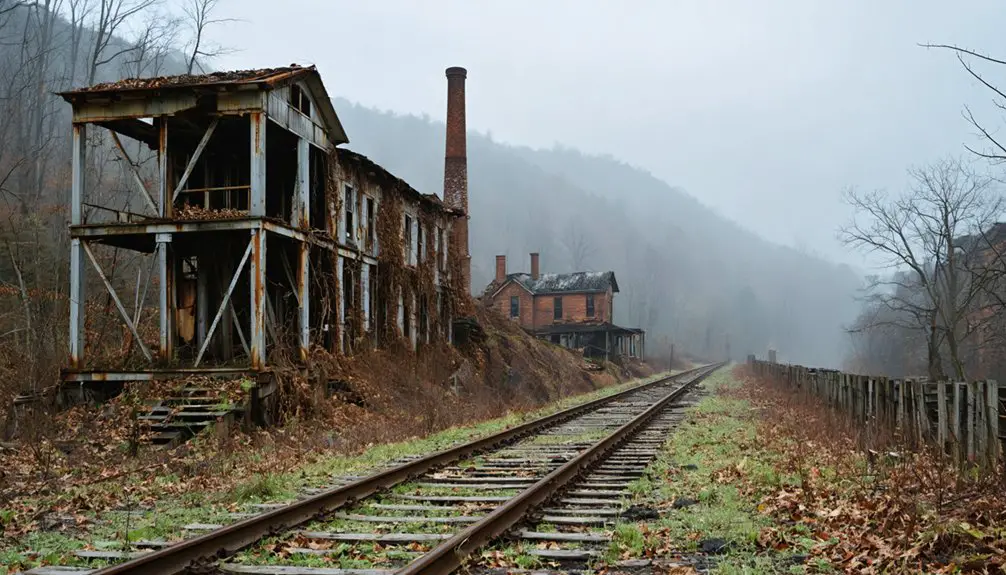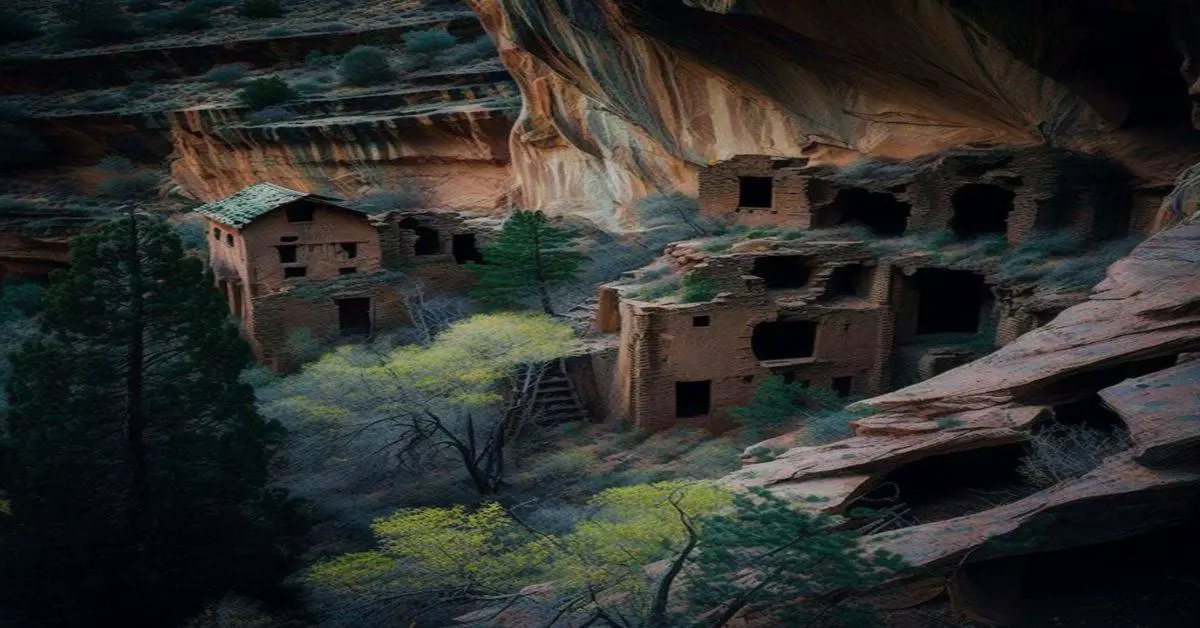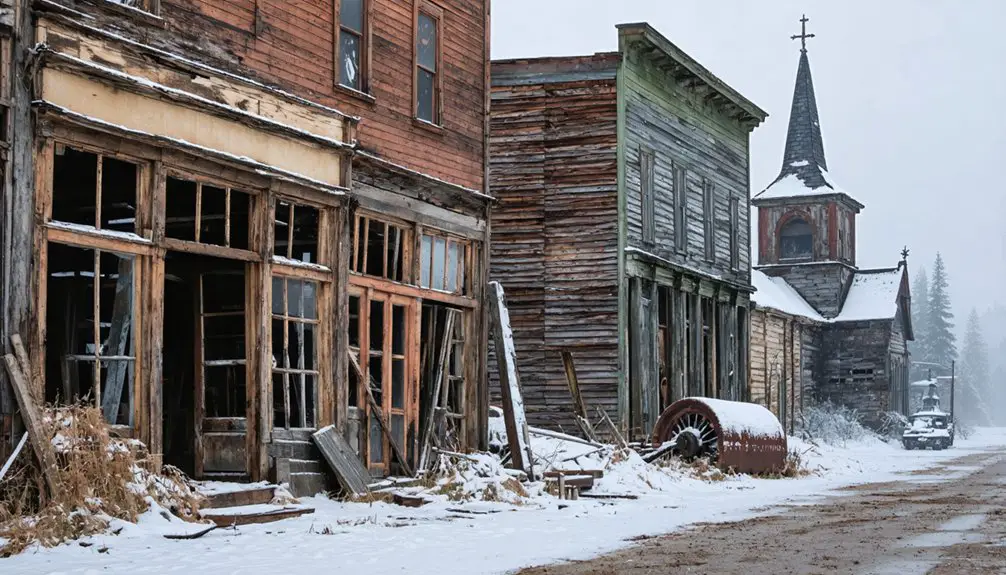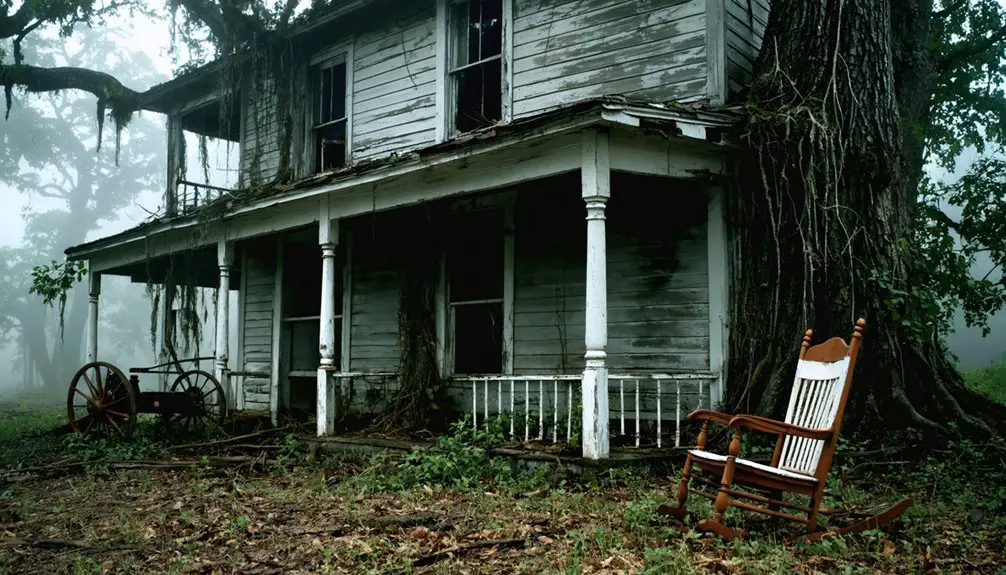You’ll find Devon nestled in Mingo County, West Virginia, a ghostly remnant of America’s coal mining past. This once-bustling company town thrived in the early 20th century, built around the coal industry that employed locals and immigrant workers from Wales and Scotland. Today, abandoned buildings and industrial ruins stand as silent witnesses to its former glory. The town’s haunting presence offers a window into the complex story of Appalachian coal communities.
Key Takeaways
- Devon was established as a coal mining town in Mingo County, West Virginia, before declining into a ghost town.
- The town’s demise was primarily caused by decreased coal demand when railroads switched from steam to diesel locomotives.
- Most original buildings still stand but are decaying, with the National Park Service protecting these structures since 1995.
- The community was once a thriving company town where coal companies controlled housing, stores, and social facilities.
- Devon’s transformation into a ghost town reflects broader changes in West Virginia’s coal industry and economic shifts.
The Rise of a Coal Mining Community
While coal deposits had been identified along the Kanawha River tributaries as early as 1742, commercial mining didn’t gain momentum until 1810 near Wheeling.
You’ll find that early community development centered around local coal use, particularly in salt furnaces that consumed about 200,000 tons by 1840.
When railroads arrived in the 1870s and 1880s, mining technology advanced rapidly. The Chesapeake & Ohio Railway connected Richmond to Huntington through the coalfields in 1873, while the Norfolk & Western Railway opened up the Pocahontas and Flat Top regions by the 1890s. Independent speculators quickly dominated land acquisition along the railway lines. With the growth of mining operations came the establishment of company towns, providing housing and essential services for the workforce.
These transportation developments transformed small mining operations into thriving enterprises. By 1883, West Virginia’s coal production reached nearly 3 million tons, creating jobs for thousands and establishing crucial economic links between regional communities and national markets.
Life in a Company Town
The rise of coal mining brought more than just industrial development to West Virginia – it created distinct social microcosms known as company towns. In these tightly controlled communities, you’d find every aspect of life dictated by coal companies, from where you lived to how you spent your wages.
A strict social hierarchy shaped your daily experience. If you were a company administrator, you’d enjoy a spacious home in a prime location. But if you were a miner, particularly a Black or immigrant worker, you’d be relegated to smaller houses in less desirable areas. Many workers came from Wales and Scotland, bringing their mining expertise to these communities. These settlements typically lasted 50 to 75 years, depending on how long the coal seams remained productive.
The company store, where you’d spend your coal scrip instead of cash, kept you financially bound to your employer. Even your social life revolved around company-owned facilities – churches, schools, and recreational spaces all served to maintain order and control.
The Economic Decline and Abandonment
Since Thurmond’s prosperity hinged entirely on coal and railroad operations, its downfall proved swift and devastating once those industries began to falter.
You’ll find that multiple economic factors converged to accelerate the community decline. The shift from steam to diesel locomotives drastically reduced the need for coal and maintenance services, while prohibition laws crushed the town’s lucrative entertainment sector.
Several devastating fires in the 1920s destroyed essential infrastructure, and rebuilding proved financially impossible as the Great Depression hit. The once-prosperous National Bank of Thurmond closed its doors permanently in 1931, marking a significant blow to the local economy.
Natural disasters and economic turmoil dealt Thurmond a brutal double blow, leaving the once-thriving town unable to recover.
The destructive 1922 fire marked a turning point from which the town never fully recovered.
Competition from rival railways and neighboring towns further eroded Thurmond’s prominence. As jobs disappeared and businesses shuttered, residents were forced to seek opportunities elsewhere.
What you’re seeing is a classic example of how overreliance on singular industries left many West Virginia towns vulnerable to rapid economic collapse.
Remnants and Ruins Today
Today’s visitors to Devon encounter a haunting tableau of architectural remnants and industrial ruins that tell the story of its dramatic decline.
You’ll find most original buildings still standing, though structural decay has taken its toll, with nature slowly reclaiming these silent sentinels of the past. Similar to five to six residents living in nearby Thurmond, Devon maintains a small but resilient population. The National Park Service has owned and protected most structures since 1995.
As you explore, you’ll discover:
- The restored railroad depot, now a visitor center, offering glimpses of industrial nostalgia
- Boarded-up storefronts along the tracks, their weathered facades hinting at former banks, hotels, and restaurants
- Scattered remains of coke ovens and rusted mining equipment hidden beneath forest growth
The National Park Service manages the site, providing walking tours with interpretive signs, though most building interiors remain off-limits for safety.
Summer visits reveal a stark contrast between human construction and nature’s persistent return.
Historical Legacy in Mingo County
Established in 1895 as West Virginia’s youngest county, Mingo County emerged from Logan County’s southern territory to become a pivotal center of Appalachian industrial development.
You’ll find Devon’s story deeply intertwined with the county’s rich cultural heritage, shaped by waves of diverse immigrants who arrived seeking opportunities in coal mining and railroad construction. Dedicated volunteers continue preserving these historical records for future generations.
The county’s legacy extends beyond its ghost towns, reflecting broader struggles that defined America’s labor movements. Commercial mining operations began when the N&W Railway arrived in 1890, transforming the region’s economic landscape.
From the historic Matewan Massacre to the rise and fall of mining communities like Devon, Mingo County’s history speaks to the resilience of working-class communities.
Today, while many mining towns stand abandoned, they’re powerful reminders of the region’s community identity and the complex relationship between industry, labor, and social change in Appalachia.
Preserving Devon’s Mining Heritage
The preservation of Devon’s mining heritage stands as a demonstration to the enduring spirit of West Virginia’s coal communities. Through community engagement efforts led by organizations like the National Coal Heritage Area, you’ll find carefully preserved structures and stories that bring the past to life.
Coal’s living legacy endures through Devon’s preserved heritage, keeping the spirit of West Virginia’s mining communities alive for future generations.
Heritage education programs connect local schools with historic sites, ensuring future generations understand their roots.
You can experience Devon’s mining legacy through:
- Interactive mining simulators that let you feel what it was like working underground
- Restored company buildings and worker housing that showcase authentic coal town architecture
- Curated exhibits featuring personal artifacts and oral histories from former mining families
These preservation initiatives protect not just physical remnants, but the cultural identity that shaped Devon’s character and its place in Mingo County’s coal heritage.
Frequently Asked Questions
Are There Any Reported Ghost Sightings or Paranormal Activities in Devon?
Through crumbling walls and silent streets, you won’t find documented ghost encounters or paranormal investigations here. Research shows no confirmed supernatural activity, though the town’s abandoned state creates an eerie atmosphere.
What Is the Closest Modern Town or City to Devon?
You’ll find Williamson, the county seat and local attractions hub, serves as your closest modern city, offering historical significance as the primary commercial center near Devon’s former location.
Can Visitors Legally Explore Devon’s Ruins, or Is It Private Property?
You should exercise caution as exploration regulations aren’t clearly defined. Without documented public access rights, property ownership likely remains private, making unauthorized visits potentially illegal without explicit permission.
What Was the Peak Population of Devon During Its Mining Heyday?
While Devon’s history echoes with the footsteps of coal miners, you won’t find exact peak population records. Based on similar mining industry towns, you’d likely have seen several hundred to a few thousand residents.
Are There Any Surviving Maps or Photographs of Devon’s Original Layout?
Your historical research won’t turn up any confirmed maps or photographs. There’s no verifiable cartographic evidence of the original layout – these records haven’t surfaced in any major archives.
References
- https://kids.kiddle.co/List_of_ghost_towns_in_West_Virginia
- https://www.youtube.com/watch?v=-EeLwLa2t90
- https://wvtourism.com/5-wv-ghost-towns/
- https://en.wikipedia.org/wiki/List_of_ghost_towns_in_West_Virginia
- https://www.wikiwand.com/en/articles/List_of_ghost_towns_in_West_Virginia
- https://www.wvencyclopedia.org/entries/1301
- https://minesafety.wv.gov/historical-statistical-data/mining-in-west-virginia-a-capsule-history/
- https://www.legendsofamerica.com/west-virginia-coal-mining/
- https://www.wvgs.wvnet.edu/www/geology/geoldvco.htm
- https://coalheritage.wv.gov/coal_history/Pages/Birth-of-the-Industry.aspx



